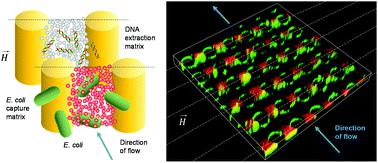Our official English website, www.x-mol.net, welcomes your
feedback! (Note: you will need to create a separate account there.)
Multifunctional magnetic nanoparticle cloud assemblies for in situ capture of bacteria and isolation of microbial DNA
Analyst ( IF 3.6 ) Pub Date : 2021-10-04 , DOI: 10.1039/d1an01297e Lucas Poncelet 1 , Lidija Malic 1 , Liviu Clime 1 , Matthias Geissler 1 , Keith J Morton 1 , Christina Nassif 1 , Dillon Da Fonte 1 , Gaétan Veilleux 1 , Teodor Veres 1
Analyst ( IF 3.6 ) Pub Date : 2021-10-04 , DOI: 10.1039/d1an01297e Lucas Poncelet 1 , Lidija Malic 1 , Liviu Clime 1 , Matthias Geissler 1 , Keith J Morton 1 , Christina Nassif 1 , Dillon Da Fonte 1 , Gaétan Veilleux 1 , Teodor Veres 1
Affiliation

|
We investigate the formation of suspended magnetic nanoparticle (MNP) assemblies (M-clouds) and their use for in situ bacterial capture and DNA extraction. M-clouds are obtained as a result of magnetic field density variations when magnetizing an array of micropillars coated with a soft ferromagnetic NiP layer. Numerical simulations suggest that the gradient in the magnetic field created by the pillars is four orders of magnitude higher than the gradient generated by the external magnets. The pillars therefore serve as the sole magnetic capture sites for MNPs which accumulate on opposite sides of each pillar facing the magnets. Composed of loosely aggregated MNPs, the M-cloud can serve as a porous capture matrix for target analyte flowing through the array. The concept is demonstrated by using a multifunctional M-cloud comprising immunomagnetic NPs (iMNPs) for capture of Escherichia coli O157:H7 from river water along with silica-coated NPs for subsequent isolation and purification of microbial DNA released upon bacterial lysis. Confocal microscopy imaging of fluorescently labeled iMNPs and E. coli O157:H7 reveals that bacteria are trapped in the M-cloud region between micropillars. Quantitative assessment of in situ bacterial capture, lysis and DNA isolation using real-time polymerase chain reaction shows linear correlation between DNA output and input bacteria concentration, making it possible to confirm E. coli 0157:H7 at 103 cells per mL. The M-cloud method further provides one order of magnitude higher DNA output concentrations than incubation of the sample with iMNPs in a tube for an equivalent period of time (e.g., 10 min). Results from assays performed in the presence of Listeria monocytogenes (at 106 cells per mL each) suggest that non-target organisms do not affect on-chip E. coli capture, DNA extraction efficiency and quality of the eluted sample.
中文翻译:

用于原位捕获细菌和分离微生物 DNA 的多功能磁性纳米粒子云组件
我们研究了悬浮磁性纳米颗粒 (MNP) 组件 (M-clouds) 的形成及其在原位的应用细菌捕获和DNA提取。M 云是在磁化涂有软铁磁 NiP 层的微柱阵列时磁场密度变化的结果。数值模拟表明,由柱子产生的磁场梯度比外部磁铁产生的梯度高四个数量级。因此,柱子作为 MNP 的唯一磁性捕获位点,MNP 聚集在每个柱子面向磁铁的相对侧。M-cloud 由松散聚集的 MNP 组成,可用作目标分析物流过阵列的多孔捕获基质。通过使用包含免疫磁性纳米颗粒 (iMNP) 的多功能 M 云来捕获大肠杆菌,证明了这一概念来自河水中的 O157:H7 以及二氧化硅包覆的 NP,用于随后分离和纯化细菌裂解时释放的微生物 DNA。荧光标记的 iMNP 和大肠杆菌O157:H7 的共聚焦显微镜成像显示细菌被困在微柱之间的 M 云区域中。使用实时聚合酶链反应对原位细菌捕获、裂解和 DNA 分离进行定量评估显示 DNA 输出和输入细菌浓度之间存在线性相关性,从而可以在 10 3确认大肠杆菌0157:H7每毫升细胞。M-cloud 方法进一步提供比样品与 iMNP 在管中孵育相同时间段(例如,10 分钟)高一个数量级的 DNA 输出浓度。在存在单核细胞增生李斯特菌(每毫升10 6 个细胞)的情况下进行的分析结果表明,非目标生物不影响芯片上的大肠杆菌捕获、DNA 提取效率和洗脱样品的质量。
更新日期:2021-10-13
中文翻译:

用于原位捕获细菌和分离微生物 DNA 的多功能磁性纳米粒子云组件
我们研究了悬浮磁性纳米颗粒 (MNP) 组件 (M-clouds) 的形成及其在原位的应用细菌捕获和DNA提取。M 云是在磁化涂有软铁磁 NiP 层的微柱阵列时磁场密度变化的结果。数值模拟表明,由柱子产生的磁场梯度比外部磁铁产生的梯度高四个数量级。因此,柱子作为 MNP 的唯一磁性捕获位点,MNP 聚集在每个柱子面向磁铁的相对侧。M-cloud 由松散聚集的 MNP 组成,可用作目标分析物流过阵列的多孔捕获基质。通过使用包含免疫磁性纳米颗粒 (iMNP) 的多功能 M 云来捕获大肠杆菌,证明了这一概念来自河水中的 O157:H7 以及二氧化硅包覆的 NP,用于随后分离和纯化细菌裂解时释放的微生物 DNA。荧光标记的 iMNP 和大肠杆菌O157:H7 的共聚焦显微镜成像显示细菌被困在微柱之间的 M 云区域中。使用实时聚合酶链反应对原位细菌捕获、裂解和 DNA 分离进行定量评估显示 DNA 输出和输入细菌浓度之间存在线性相关性,从而可以在 10 3确认大肠杆菌0157:H7每毫升细胞。M-cloud 方法进一步提供比样品与 iMNP 在管中孵育相同时间段(例如,10 分钟)高一个数量级的 DNA 输出浓度。在存在单核细胞增生李斯特菌(每毫升10 6 个细胞)的情况下进行的分析结果表明,非目标生物不影响芯片上的大肠杆菌捕获、DNA 提取效率和洗脱样品的质量。









































 京公网安备 11010802027423号
京公网安备 11010802027423号